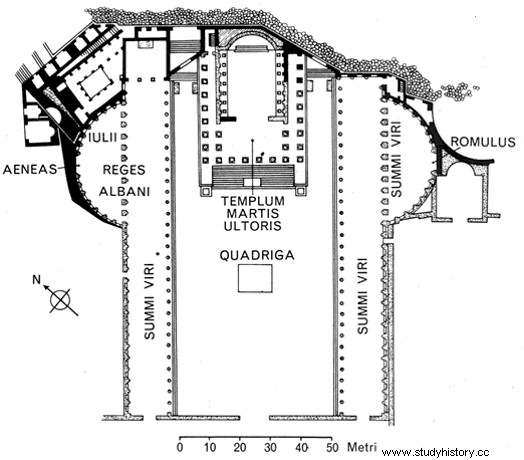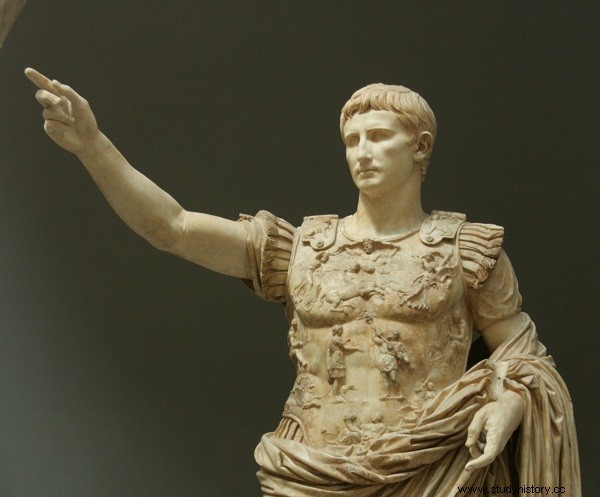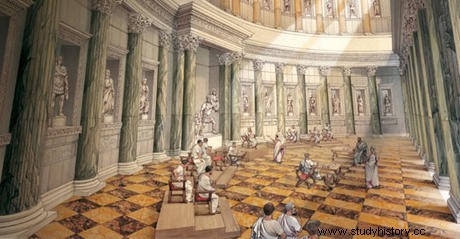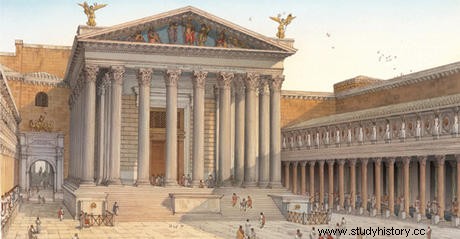On this occasion we will deal with the reasons why Augusto decided to create a new forum. The political and propaganda ideology to elevate his role within the history of Rome, using symbolic sculptural language for this purpose. The Roman historian Suetonius enlightens us once again with his immortal work Lives of the Twelve Caesars , commenting on the realization of the Forum of Augustus:“ he built the forum due to the growing demand of the number of litigants and businesses, since the first two were insufficient ”. The brutal growth of the Roman bureaucracy, coupled with the vast extension of territories conquered since the time of Julius Caesar, demanded new public spaces. But the architecture and decoration used for its realization attest that this was not the main reason for the creation of a new forum. His own greatness was what Augusto was looking for with this great work made with the most exquisite Carrara marble.

Forum of Augustus plan
For the realization of it, he financed it with the money obtained in spoils of war, as Julius Caesar had already done for his own forum. At the same time, Suetonius tells us that the temple built in the forum, dedicated to Mars Ultor e, (avenger), is due to a vote made before the battle of Filippi in which he defeated in 42 B.C. Along with Marco Antonio to the murderers of his great-uncle and adoptive father Julius Caesar, thus obtaining his revenge on Cassio and Brutus. Although as we will see later, this was not the only reason why Augustus built it. Once Augustus had defeated his former ally Antony and his wife Cleopatra at Actium sea battle , at 31 a. C., he seized all the power of the Republic, as Julius Caesar did 17 years before after defeating Pompey. This is a key moment, and Octavian Augustus was wise while Julius Caesar was not. Caesar proclaimed himself dictator for life, and his enemies assassinated him for fear that he would proclaim himself king, so the Romans hated monarchy!
Augustus, on the other hand, knew how to govern the Republic in a personalistic way, survived it and ended up creating a new monarchy. To this end, Augustus always acted without creating suspicions of tyranny in the people and in the Senate. He created a great political and propaganda apparatus showing that, without a doubt, he was the most intelligent politician in the history of Rome. This is where the Forum has its reason for being, as well as the Ara Pacis , the Aeneid of Virgil or the History of Rome of Titus Livy. All these literary and architectural works served Augustus to show his respect for the Republic, its institutions, its morals, its laws and traditions, at the same time that he places his family, the gens Julia , as descendants of the gods and himself as the culminating figure in Roman history after a century of civil wars and permanent political instability. He brought peace and prosperity to the people by returning to Rome its lost glory, so in this way he endorses that he is the only and legitimate ruler, like a new Romulus; the father or father of the country.

His political strategy of personal exaltation of him is evident in the sculptural iconographic program developed in the various elements of the forum . The Temple of Mars Ultore concentrates the aspects of the Roman war and triumph. Here the Senate met to decide on the declarations of war, proclaimed the victories and signed peace. Foreign princes who came to Rome for subjugation or to create alliances were also received. On the altar of the temple the governors celebrated sacrifices before going to the provinces.
Inside the temple were three divinities. Mars as a warrior, clad in arms and armor, as an avenger of the death of Julius Caesar. Venus Genitrix , as mother of Aeneas and this father of Ascanio, founder of Alba Longa and of the Gens Julia according to tradition, exalted by Julius Caesar and now by Augustus. She also represents peace, as it was she who disarmed Mars. Finally the figure of Julius Caesar appeared deified, a deification that Augustus himself commissioned to give greater legitimacy and respect to his house. The action of deifying a human was strange to the Romans of that time but very common in the eastern provinces of ancient traditions. It is one of many things that Augustus changed in Roman history and culture.
In the pediment of the entrance porch to the temple, in the manner of the Greek temples, we find the most important hierarchy sculptures in the entire forum. In the center of the composition, the most prominent position, for Mars once again, since the temple is dedicated to him. To one side appears again Venus and Romulus . The latter represents the traditional Roman virtues. He is the founder of Rome and a descendant of Ascanius and his successors in the kingdom of Alba Longa, Augustus being therefore a descendant of Romulus. Finally, the symbolic representation of the Palatine Hill , one of the seven hills of Rome and the residence of Augustus and future emperors.
On the other side of Mars we find two allegorical goddesses:Fortune carrying the cornucopia or horn of plenty and the goddess Roma , as a personification of the city. Finally, the deified representation of the river Tíber would be found. , the river that runs through Rome.
In the exedras and porticoed galleries we find marble and gilded bronze statues inside niches, with an inscription on each of them with a brief reference to each character (elogium) . In the two galleries and in the southeast exedra there were statues representing the Summi Viri or great characters in the history and legend of Rome, especially victorious generals, since we find ourselves in a set dedicated to war. Augustus placed Romulus in the center of the exedra, the prominent place. carrying the conquered war trophies (spolia opima).

Reconstruction of one of the exedras
In the northwestern exedra, in the center is Aeneas , the Trojan hero son of Venus who left Troy in flames with his family:his father Anchises and his son Ascanio . The figure of Aeneas used to be associated with the virtue of the pietas :filial piety, religious and patriotic. To one side of Aeneas there are statues representing the ancient kings of Alba Longa, a kingdom founded on the Alban mountains, on the outskirts of Rome, and considered to be the predecessor kingdom of Rome. And finally, on the other side we see the most outstanding members of the Gens Julia . Augustus shows himself and his lineage as the worthy direct heirs of the gods and the founding heroes of the city, legitimizing his position of power.
The last element to mention is the sculptural group located in the middle of the forum square. It shows us Augustus in a triumphal chariot, like the ones used by victorious generals in parades after a military victory. The inscription Pater Patriae appears or father of the country, a distinction that was granted by the Senate.

Reconstruction of the square of the Forum of Augustus
The Forum of Augustus was finished in 2 BC, 40 years after it began. Sufficient time for Augustus' entrenchment in power. For its inauguration, some games were held in honor of the god Mars, the Ludi Martiales, and a naumaquia representing the naval battle of Actium, in which the troops of Augustus and his general Marco Agrippa defeated Marco Antonio and Cleopatra.
It must have been a great spectacle to walk through those spaces in their full splendor. The forum was held in order to leave the population ecstatic. Something like that was never seen. Although today we think that all of Rome was made of marble, it was not; In fact, Augustus in his biography boasted of having found a Rome made of clay, leaving it covered with marble.
Collaboration with Rafael Heranz
Sources:"Una giornata nell' antica Roma", Alberto Angela. "Guiede archeologiche:Rome", Filippo Coarelli. Forum of Augustus
